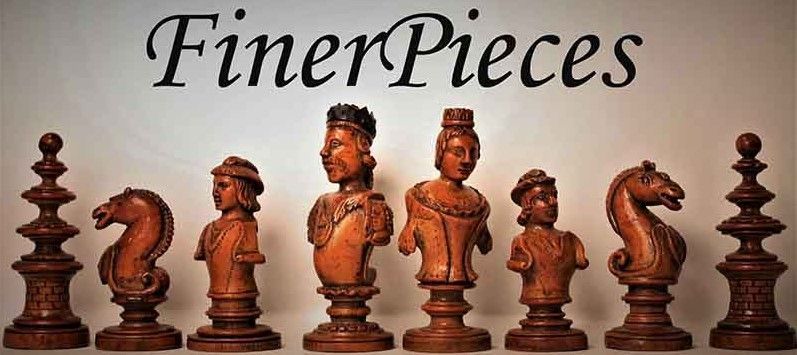Anglo-German Catalin Staunton Chess Set, ca. 1930
Here is a very special and beautiful chess set distributed by F.H.Ayres in England, presumably in the 1930's. The pieces come in a box with separate compartments for the white and the black pieces and a folding leather board with black and cream colored squares stored underneath.
While the box is not bearing the F.H.Ayres logo, I am nonetheless sure that this set was distributed by Ayres for two reasons. Firstly, I have seen exactly the same pieces and board in a different box with the F.H.Ayres logo. Secondly, the box used for my set is similar to other F.H.Ayres boxes, e.g. used for the well known Ayres horse racing games. In particular, the locking mechanism is absolutely similar and typical for Ayres.
The design of the pieces itself is similar to those produced by K.P.Uhlig in Germany. I therefore assume that Uhlig was either producing these sets for Ayres or had its designed licensed to Ayres for the production of these sets. It is in my view therefore an Anglo-German co-production.
The pieces are made of Catalin, which is an artificial material quite comparable to bakelite. In fact, these sets have been described as being made of bakelite, but this is in my view wrong. Catalin is a brand name which was trademarked in 1927 by the American Catalin Corporation of New York City, when the company acquired the patents for bakelite. The material itself is a phenol-formaldehyde resin such as bakelite, Prystal, Marbelette or Durez. It was produced only for the relatively short period from 1928 to shortly after the end of the Second World War. The reason for this was the costly production process. Catalin was cast in lead moulds and had to harden between five and seven days at 80 degrees Celsius. Reworking, cooling, grinding, waxing and polishing took two more days. As early as 1935, the American Catalin Corporation launched a successor to Catalin in the form of Prystal. Catalin was still used afterwards, but by the end of the 1940s at the latest it had been replaced by cheaper plastics. However, it had a decisive advantage over bakelite, which can be clearly seen in this chess game. While bakelite could only be produced in a few dark colours, the new plastic Catalin succeeded in creating a colourful palette, including bright yellow and orange, as in this set, in which the white figures are in a bright butterscotch.
The little ball finials on the black Queen and on a white Bishop are missing and the tip of two Knights' ears has broken off, but apart from that the set is in very good condition.















